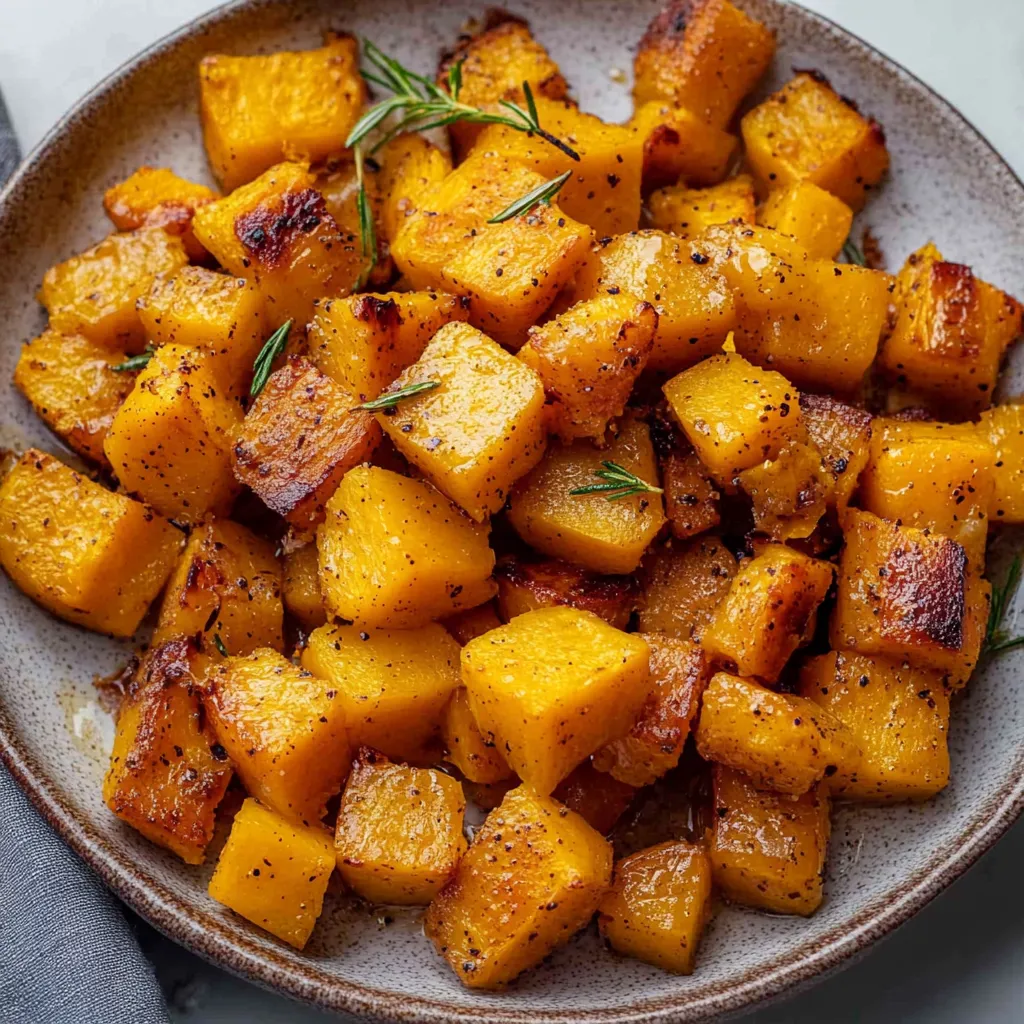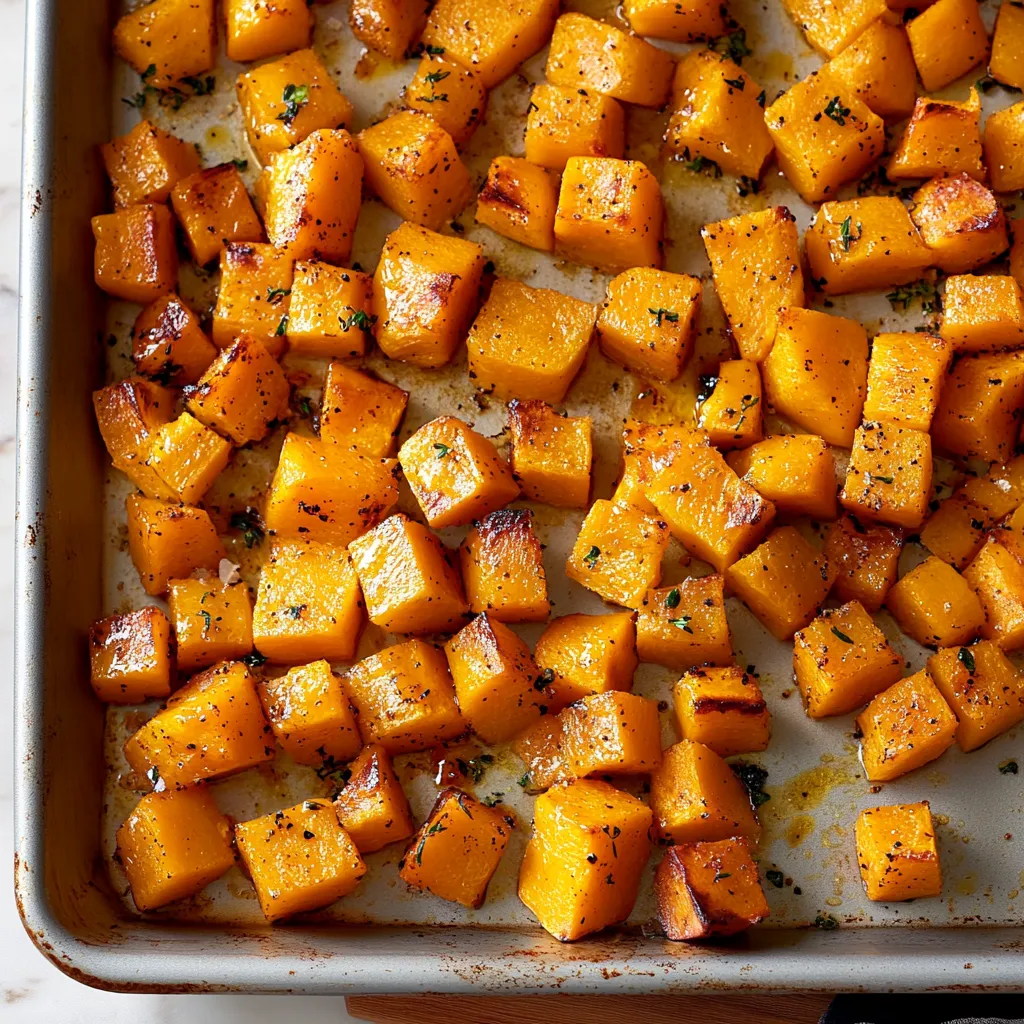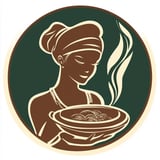 Pin it
Pin it
This roasted butternut squash transforms an ordinary weeknight vegetable into something truly spectacular with the simple addition of maple syrup, warm cinnamon, and fresh rosemary that creates layers of flavor perfect for special occasions. Each tender, caramelized cube delivers natural sweetness enhanced by maple's richness, warm spice from cinnamon, and bright herbal notes from fresh rosemary that make this side dish memorable enough for holiday tables. The best part is how easy it is to prepare - just cube, toss with seasonings, and roast until golden and tender, creating restaurant-quality results with minimal effort.
Why You'll Love This Recipe
I created this recipe when I needed something more special than my usual olive oil, salt, and pepper roasted vegetables but didn't want to spend hours in the kitchen creating complexity. The addition of maple syrup and cinnamon was inspired by classic fall flavors, while the fresh rosemary adds that sophisticated touch that makes people think you spent much more time and effort than you actually did. Now this has become my go-to side dish whenever I want to make an ordinary meal feel extraordinary, and guests always ask for the recipe because they can't believe something so delicious could be so simple to make.
Ingredients
- Medium butternut squash (1, about 2-3 lbs): Choose one that feels heavy for its size with a long neck, which is easier to peel and cube
- Extra virgin olive oil (3 tablespoons): Essential for caramelization and preventing the squash from drying out during roasting
- Pure maple syrup (2 tablespoons): Use real maple syrup rather than pancake syrup for the best flavor depth and natural sweetness
- Ground cinnamon (1 teaspoon): Provides warm, aromatic spice that complements the squash's natural sweetness perfectly
- Salt (1 teaspoon): Enhances all flavors and helps draw out the squash's natural sweetness during roasting
- Freshly ground black pepper (1/2 teaspoon): Adds gentle warmth and complexity to balance the sweet elements
- Fresh rosemary (2 tablespoons, chopped): Added after roasting to provide bright, pine-like fragrance and sophisticated flavor
Instructions
- Step 1:
- Preheat oven and prepare baking sheets. Set your oven to 400°F and line two large baking sheets with parchment paper or lightly coat with cooking spray. Having two sheets ensures the squash isn't overcrowded, which is crucial for proper caramelization.
- Step 2:
- Prepare the butternut squash safely. Using a sharp chef's knife, cut off both ends of the squash to create stable, flat surfaces. Stand the squash upright and carefully peel with a vegetable peeler, working from top to bottom in long strokes.
- Step 3:
- Cut squash into uniform pieces. Cut the squash crosswise where the neck meets the bulbous end. Cut each section in half lengthwise, then scoop out seeds and pulp from the bottom section. Cut all pieces into uniform 1-inch cubes for even cooking.
- Step 4:
- Season the squash thoroughly. In a large bowl, combine the cubed squash with olive oil, maple syrup, cinnamon, salt, and pepper. Toss until every piece is evenly coated with the seasoning mixture.
- Step 5:
- Arrange for optimal roasting. Divide the seasoned squash between the two prepared baking sheets, spreading pieces in a single layer with space between each cube. Overcrowding causes steaming instead of roasting, preventing proper caramelization.
- Step 6:
- Roast until caramelized and tender. Bake for 15 minutes, then remove pans and flip each piece with a spatula for even browning. Return to oven and continue roasting for 10-15 minutes until tender and golden brown on multiple sides.
- Step 7:
- Test for perfect doneness. The squash should be easily pierced with a fork and have golden, caramelized edges. If pieces still feel firm, continue roasting in 5-minute increments until properly tender.
- Step 8:
- Finish with fresh herbs. Remove from oven and immediately sprinkle with fresh chopped rosemary while the squash is still hot. The residual heat will release the rosemary's aromatic oils for maximum flavor impact.
- Step 9:
- Serve immediately for best results. Transfer to a serving dish and serve warm to enjoy the perfect contrast of caramelized exterior and creamy interior texture.
 Pin it
Pin it
Mastering Butternut Squash Preparation
The key to enjoying butternut squash lies in proper preparation, which is much simpler than many people think. The vegetable peeler method is by far the easiest approach - much more efficient than trying to roast and then peel, or struggling with complicated cutting techniques. A sharp peeler and stable cutting surface make the job quick and safe.
When cutting, aim for uniform pieces that will cook evenly. Don't worry if some pieces aren't perfect cubes - the irregular shapes from the bulbous end will still taste delicious and actually add visual interest to the finished dish. The goal is consistent size rather than perfect geometry.
Understanding the Flavor Development Process
The magic in this recipe happens during the roasting process when natural sugars in the squash caramelize and concentrate while the maple syrup creates a beautiful glaze. The cinnamon becomes more mellow and complex when heated, while the olive oil helps everything brown evenly and prevents drying out.
Adding the rosemary after roasting rather than before is crucial - fresh herbs can burn and become bitter during the long roasting time, but adding them to hot vegetables releases their essential oils without destroying their bright flavor.
Achieving Perfect Caramelization
Proper caramelization requires adequate space between squash pieces and the right temperature. Overcrowding creates steam that prevents browning, while too low temperature won't develop those coveted golden edges. The 400°F temperature strikes the perfect balance between cooking the interior and browning the exterior.
Flipping the pieces halfway through ensures even browning on multiple sides. Don't flip too early or the pieces may stick to the pan - wait until they've had time to develop a golden crust that releases easily from the parchment.
Make-Ahead and Storage Strategies
This roasted butternut squash is perfect for meal prep and entertaining because it can be prepared in advance and reheats beautifully. You can cube the raw squash up to a day ahead and store it covered in the refrigerator, making final preparation much quicker when you're ready to cook.
Leftover roasted squash keeps well for up to five days in the refrigerator and can be reheated in the oven, stovetop, or microwave. The oven method at 350°F maintains the best texture, while stovetop reheating in a skillet with a little oil can actually re-crisp the edges slightly.
Creative Variations and Seasonal Adaptations
While this maple-cinnamon version is absolutely perfect for fall and winter, the basic roasting technique works beautifully with many other flavor profiles. Try Mediterranean versions with olive oil, rosemary, and balsamic vinegar, or Middle Eastern inspired combinations with cumin, paprika, and a drizzle of pomegranate molasses.
For different seasons, consider adding orange zest and thyme in spring, or curry powder and coconut oil for an Indian-inspired variation. The neutral, sweet flavor of butternut squash welcomes many different spice combinations while maintaining its essential character.
Serving Suggestions and Pairing Ideas
This roasted butternut squash works beautifully as both a side dish and as an ingredient in other preparations. It pairs perfectly with roasted meats like turkey, pork, or chicken, while being substantial enough to serve as a vegetarian main course when combined with grains and proteins.
Consider using leftovers in grain bowls, salads, or pasta dishes where the sweet, caramelized flavors add interest and nutrition. The squash also makes an excellent addition to breakfast hash or can be pureed into soups for added richness and flavor.
Health Benefits and Nutritional Value
Butternut squash is one of the most nutritious vegetables you can include in your diet, packed with vitamin A, vitamin C, potassium, and fiber while being naturally low in calories. The deep orange color indicates high levels of beta-carotene, a powerful antioxidant that supports immune function and eye health.
The addition of olive oil actually helps your body absorb the fat-soluble vitamins in the squash, while the maple syrup provides natural sweetness without the need for processed sugars. This combination creates a side dish that's both indulgent-tasting and genuinely nutritious.
You Must Know
I love how this recipe proves that sometimes the simplest additions can transform ordinary ingredients into something truly special. Every time I make this roasted butternut squash, I'm amazed by how those few extra ingredients - maple syrup, cinnamon, and fresh rosemary - can elevate humble vegetables into something that feels elegant and indulgent. It's become my signature side dish for fall entertaining because it looks beautiful, tastes incredible, and requires so little effort that I can focus on other parts of the meal while still serving something that impresses every single time.
Professional Chef Tips
This roasted butternut squash recipe embodies everything I believe about seasonal cooking - taking advantage of beautiful fall produce and treating it with the respect and care it deserves to create something that nourishes both body and soul. Every time I serve this dish, I'm reminded that some of the most satisfying meals come from simple ingredients prepared with attention to technique and an understanding of how flavors work together to create something greater than the sum of their parts.
Frequently Asked Questions
- → How do I know when the butternut squash is done?
- The squash is ready when you can easily pierce it with a fork and the edges are golden brown and slightly caramelized.
- → Can I make this recipe ahead of time?
- Yes! You can cut the squash up to one day before cooking and store it in the fridge. The cooked squash keeps for 4-5 days.
- → What's the best way to cut butternut squash?
- Peel the squash with a vegetable peeler, cut it in half lengthwise, scoop out the seeds, then cut into 1-inch cubes for even cooking.
- → Can I use regular salt instead of kosher salt?
- Use less table salt since it's finer and saltier than kosher salt. Start with 1 teaspoon and taste before adding more.
- → What can I serve with roasted butternut squash?
- It pairs great with roasted chicken, turkey, pork chops, or as part of a grain bowl with quinoa or rice.
- → Can I freeze leftover roasted butternut squash?
- Yes, freeze it for up to 3 months. The texture will be softer after thawing, but it's still tasty and safe to eat.
